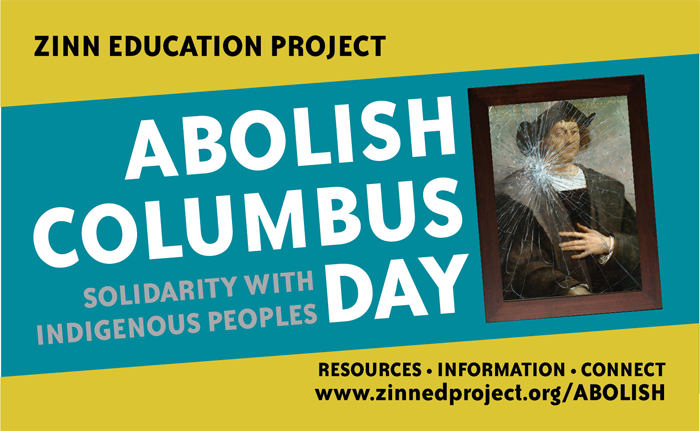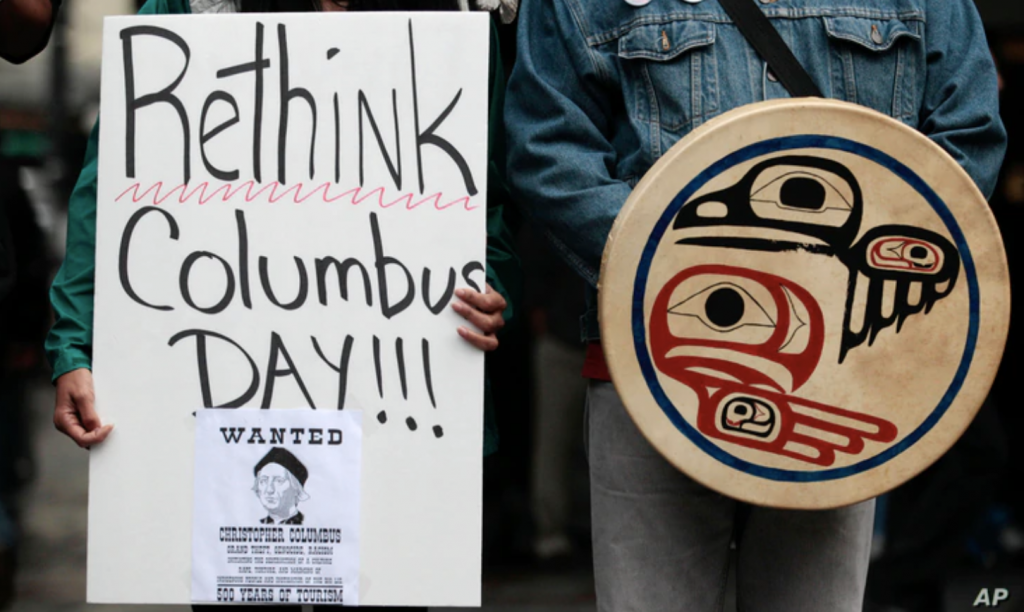In fourteen hundred ninety-two Columbus sailed the ocean blue. .......... Read the updated version of the classic children's poem, as revised (and with much greater accuracy) by Dana W. Hall.
I still remember learning the rhyme about Christopher Columbus in grade school in the ’90s. Back then, a whitewashed and sanitized version of history is what most students in the United States were taught, and while progress has been made since, there are still too many children who learn—and adults who believe—the propaganda about Christopher Columbus.


(AP/VOA News)
SPOILER ALERT: Christopher Columbus was NOT a Super Awesome Person™.
In the sanitized version of Columbus’ voyages (as popularized in 19th century fiction and 20th century poetry), Columbus “proved” the Earth was round (nope) when he “discovered” America (also nope) and “befriended” the Indigenous people—very, very nope.
As summarized by History.com, here is the real legacy of Columbus:
As modern historians began peeling back the myths surrounding Columbus, they painted a picture of a deeply flawed man who, as the short-lived governor of the island of Hispaniola (now Dominican Republic and Haiti), ordered the enslavement and murder of countless native Taino people there. Having arrived in the West Indies as the international slave trade was heating up, Columbus and his men forced the Taino to work on plantations and mine for gold—and shipped others to Spain to be sold. As governor, he ordered brutal crackdowns on any unrest. And under his rule, according to a book by Bartolomé de las Casas, a Dominican friar who came to Hispaniola on one of Columbus’s later voyages, the Spaniards committed savage acts of slaughter, torture and sexual violence against the peaceful Taino.
Columbus’s legacy also includes forcing the islands’ indigenous people to convert to Christianity and introducing smallpox and other new diseases for which they had no immunity. Between slavery, disease, overwork and famine, it is estimated that the Taino people were reduced from hundreds of thousands at the time of Columbus’s arrival to just a few hundred some 60 years later.
The Oatmeal has a much more graphic account of the ways Columbus and his men raped, tortured, enslaved, and slaughtered the Lucayan people of the Bahamas. The Oatmeal also makes the case for honoring Bartolomé de las Casas by transforming Columbus Day into Barolomé Day. Las Casas was a reformed colonizer and slaveowner who became a priest and spent half a century advocating for human rights and against the brutalities of slavery and colonization.
For decades, Native American activists have opposed the celebration of Columbus’s legacy, and as of 2020, fewer than half of the states recognize Columbus Day, with other states opting to celebrate Indigenous Peoples’ Day, Native American Day, American Indian Day, or opting out of celebrations altogether.
The Zinn Education Project (which I first wrote about here) has an ongoing campaign to Abolish Columbus Day, in solidarity with the Indigenous people who have demanded an end to Columbus Day. They provide resources and information to help schools and communities petition administrations and introduce legislation to rename Columbus Day to Indigenous Peoples’ Day. Learn more about the campaign and join today!
Read More About the Legacy of Christopher Columbus and the Founding of Columbus Day
- Christopher Columbus: How The Explorer’s Legend Grew—and Then Drew Fire (History.com)
- What Columbus Day Really Celebrates: The “Most Massive Act of Genocide” in World History (Salon)
- Abolish Columbus Day Campaign (Zinn Education Project)
- Columbus Day (The Oatmeal)
- “Fourteen Hundred Ninety-Two”: The Columbus Poem Rewritten (Indian Country Today)
- How Columbus Sailed Into U.S. History, Thanks To Italians (NPR)
- Top 5 Atrocities Committed by Christopher Columbus (Rapid City Journal)
- Why Columbus Day Courts Controversy (History.com)
- In 1492, Columbus Sailed the Ocean Blue… And Slaughtered the Indigenous Peoples He Found (The Guardian)